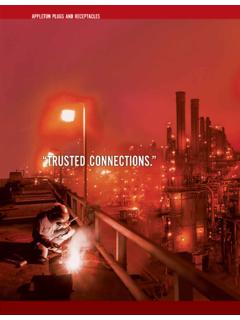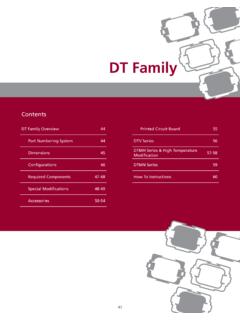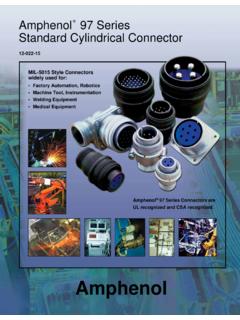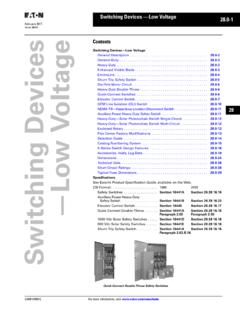Transcription of Appleton NEC 2014 Code Review - emerson.com
1 NEC 2014 CodE REviEwA GuidE foR usE of ElECtRiCAl PRoduCts in Hazardous LocationsTable of ConTenTsINTRODUCTION AND GENERAL INFORMATIONP urpose of the Review1 Code Excerpts/Notations1 Technical Help Available3 Disclaimer3 Permissions3 Trade Sizes3 Most Appleton Products Designed for Hazardous Locations are Suitable for All Classes3 Appleton Products Meet or Exceed Authorized Standards3 Introduction4 Appleton Registered Trademarks; Metric Designator and Trade Size5 Types of Explosionproof Construction ( Appleton Products)6-7 NEC ARTICLES 500 THROUGH 516 TEXT AND COMMENTARYA rticle 500 Hazardous (Classified) Locations, Class I, II, and III, Divisions 1 and 2 Changes to Article Scope Articles 500 Through Other Classifications of Material Protection Specific Occupancies20 Article 501 Class I LocationsChanges to Article Zone Wiring Sealing and Process Conductor Insulation, Class I, Divisions 1 and Uninsulated Exposed Parts, Class I, Divisions 1 and Grounding and Bonding, Class I, Divisions 1 and Surge Transformers and Meters, Instruments, and Switches, Circuit Breakers, Motor Controllers, and Control Transformers and Motors and Utilization Flexible Cords, Class I, Divisions 1 and Receptacles and Attachment Plugs, Class I.
2 Divisions 1 and Signaling, Alarm, Remote-Control, and Communications Systems432014 Code ReviewiTable of ConTenTsii2014 Code ReviewArticle 502 Class II LocationsChanges to Article Explosionproof Zone Wiring Sealing, Class II, Divisions 1 and Uninsulated Exposed Parts, Class II, Divisions 1 and Grounding and Bonding, Class II, Divisions 1 and Surge Protection Class II, Divisions 1 and Transformers and Switches, Circuit Breakers, Motor Controllers, and Control Transformers and Motors and Ventilating Utilization Flexible Cords Class II, Divisions 1 and Receptacles and Attachment Signaling, Alarm, Remote-Control, and Communications Systems; and Meters, Instruments, and Relays54 Article 503 Class III LocationsChanges to Article Zone Wiring Uninsulated Exposed Parts, Class III, Divisions 1 and Grounding and Bonding Class III, Divisions 1 and Transformers and Capacitors Class III, Divisions 1 and Switches, Circuit Breakers, Motor Controllers, and Fuses Class III, Divisions 1 and Control Transformers and Resistors Class III, Divisions 1 and Motors and Generators Class III, Divisions 1 and Ventilating Piping Class III, Divisions 1 and Luminaires Class III, Divisions 1 and Utilization Equipment Class III, Divisions 1 and Flexible Cords Class III.
3 Divisions 1 and Receptacles and Attachment Plugs Class III, Divisions 1 and Signaling, Alarm, Remote-Control, and Local Loudspeaker Intercommunications Systems Class III, Divisions 1 and Electric Cranes, Hoists, and Similar Equipment Class III, Divisions 1 and Storage Battery Charging Equipment Class III, Divisions 1 and 262 Article 504 Intrinsically Safe SystemsChanges to Article Application of Other Equipment Installation64 Table of Wiring Separation of Intrinsically Safe Identification66 Article 505 Zone 0, 1, and 2 LocationsChanges to Article Other Classifications of Material Special Protection Wiring Sealing and Flexible Cords and Conductors and Conductor Uninsulated Exposed Equipment Increased Safety e Motors and Grounding and Process Sealing83 Article 506 Zone 20, 21, and 22 Locations for Combustible Dusts or Ignitable Fibers/FlyingsChanges to Article Other Classification of Material Special Protection Equipment Wiring Flexible Equipment Grounding and Bonding93 Article 510 Hazardous (Classified)
4 Locations SpecificChanges to Article General952014 Code ReviewiiiTable of ConTenTsiv2014 Code ReviewArticle 511 Commercial Garages, Repair and StorageChanges to Article Area Classification, Wiring and Equipment in Class I Wiring and Equipment Installed Above Class I Special Ground-Fault Circuit-Interrupter Protection for Grounding and Bonding Requirements100 Article 513 Aircraft HangersChanges to Article Classification of Wiring and Equipment in Class I Wiring and Equipment Not Installed in Class I Underground Special Ground-Fault Circuit-Interrupter Protection for Grounding and Bonding Requirements104 Article 514 Motor Fuel Dispensing FacilitiesChanges to Article Classification of Wiring and Equipment Installed in Class I Wiring and Equipment Above Class I Underground Circuit Provisions for Maintenance and Service
5 Of Dispensing Grounding and Bonding110 Article 515 Bulk Storage PlantsChanges to Article Class I Wiring and Equipment Located in Class I Wiring and Equipment Above Class I Underground Special Equipment Gasoline Grounding and Bonding112 Table of ConTenTsArticle 516 Spray Application, Dipping, Coating, and Printing Processes Using Flammable or Combustible MaterialsChanges to Article Classification of Wiring and Equipment in Class I Wiring and Equipment Not Within Classified Special Grounding126 APPENDIXESA ppendix A-1: Class I Flammable Gases And Vapors127-132 Appendix A-2: Class II Combustible Dusts133-136 Appendix B-1: Applicable Product Standards137-138 Appendix B-2: NEMA Enclosure Definitions139 Appendix B-3: Comparison Between NEMA Enclosure Type Numbers and IEC Enclosure Classification Designations140-141 Appendix C: Standards, Testing and Certification142-143 Appendix D: Quick Selection Guide Equipment for Hazardous Locations144-147 Appendix E-1: Lighting and Power Diagrams: Class I, Divisions 1 and 2, Group B; Class I, Zones 1 and 2, Groups IIA, IIB + H2148-149 Appendix E-2: Power Diagram: Class I, Division 1, Groups C and D, Class I, Zone 1, Groups IIA, IIB150-151 Appendix E-3: Lighting Diagram: Class I, Division 1, Groups C and D.
6 Class 1, Zone 1, Groups IIA and IIB152-153 Appendix E-4: Lighting and Power Diagram: Class I, Division 2, Groups C and D; Class I, Zone 2, Groups IIA and IIB154-155 Appendix E-5: Power Diagram: Class II, Divisions 1 and 2, Groups E, F and G; Class II, Zones 21 and 22156-157 Appendix E-6: Lighting Diagram: Class II, ivisions 1 and 2, Groups E, F and G; Class II, Zones 21 and 22158-159 Appendix E-7: Lighting and Power Diagram: Class I, Zone 1; Class I, Zone 2160-161 Appendix F: Glossary of Definitions1622014 Code ReviewvNotes:vi2014 Code ReviewIntroductIon and General InformatIonPURPOSE OF THE Review Assist in interpreting the requirements of Articles 500-516 of the 2014 NEC To provide information that will assist in minimizing the fire and explosive hazards encountered in classified locations, including references to sources where more detailed information can be obtained.
7 To acquaint the reader with the various types of electrical equipment, and equipment design, used in hazardous locations. To provide a guide for the correct selection and installation of electrical products in hazardous (classified) locations, in conformance with the National Electrical Code .CODE EXCERPTS/NOTATIONS NEC Articles 500 thru 516 indicated with blue text. For the 2014 Appleton Code Review , the commentary text, where practical, has been located directly following the published NEC rule. Commentaries on NEC presented in black text. Underlined text indicates change from previous NEC that is extracted from another standard has not been compromised or violated.
8 Any editing of the extracted text is consistent with that of the NEC .Appendix A contains tables of flash points for common hazardous gases as well as information on ignition temperatures for hazardous B contains an informative list of associated installation standards for electrical equipment with which Appleton products are designed, tested, and manufactured to comply. This appendix also includes the NEMA Enclosure Type definitions and a practical conversion chart that can be used to convert a NEMA Enclosure Type to an IEC IP C contains an informative list of electrical and fire safety organizations. Appendix D contains an informative quick selection guide of Appleton products for each type of hazardous E contains clarifying diagrams of typical Appleton hazardous location product F contains a descriptive glossary of Code Review1 NOTES:22014 Code ReviewIntroductIon and General InformatIonTECHNICAL HELP AVAILABLEThe information presented in this booklet provides extensive help in determining NEC requirements for the use of electrical products in hazardous locations.
9 However, even though every attempt has been made to provide complete data, questions inevitably arise. In these circumstances, contact your local Appleton representative for technical assistance. In addition, Appleton s staff of technical experts is at your NEC and other NFPA Standards are international standards. All measurements in the 2014 NEC are shown in SI metric units, followed by the inch-pound value in parenthesis. For example, mm (1/16 in.).A soft metric conversion is when the dimensions of a product already designed and manufactured to the English or Imperial inch-pound system have their dimensions converted to metric dimensions.
10 The product does not hard metric measurement is where a product has been designed to SI metric dimensions. No conversion from English or Imperial inch-pound measurement units is hard conversion is where an existing product is redesigned into a new size. For example, if a dimension is required to be 10 feet, it is shown in the NEC as m (10 ft.). Where rounding off would create a safety hazard, the metric conversions are mathematically identical. Note that the 10 feet remains the same, and the metric value of m appears and has not been rounded off to information presented in this booklet has been assembled from various sources.














![Index [www.amphenol-in.com]](/cache/preview/0/9/5/a/5/c/0/b/thumb-095a5c0b30a3a0193e93b532e7102f9f.jpg)

